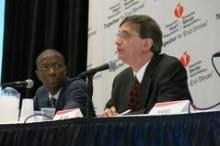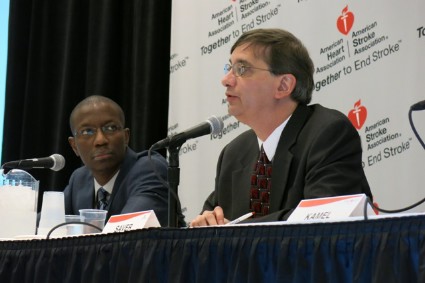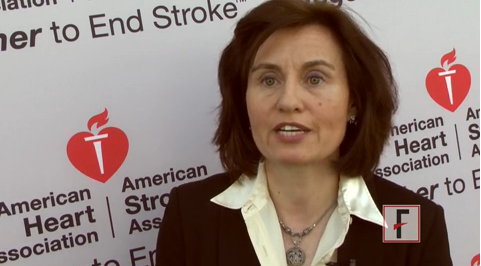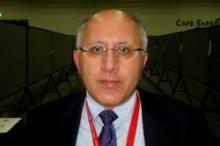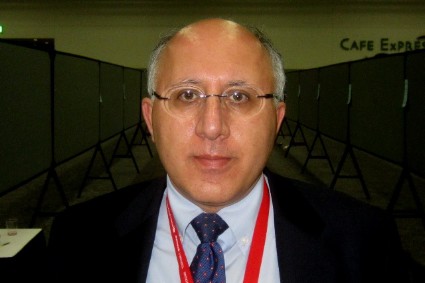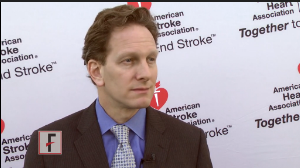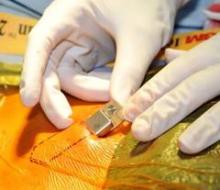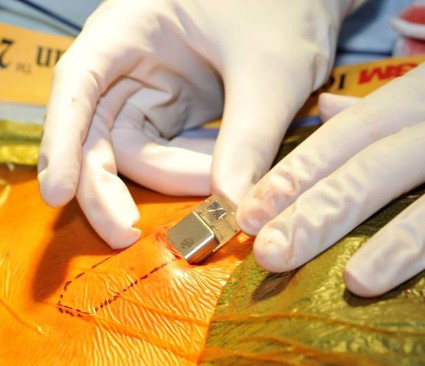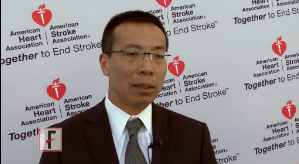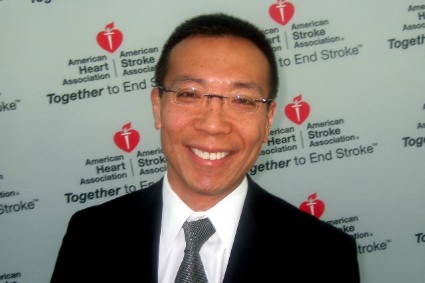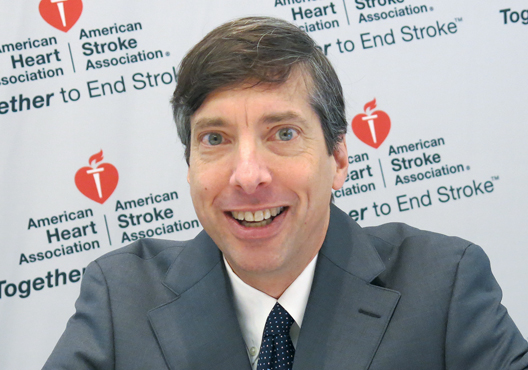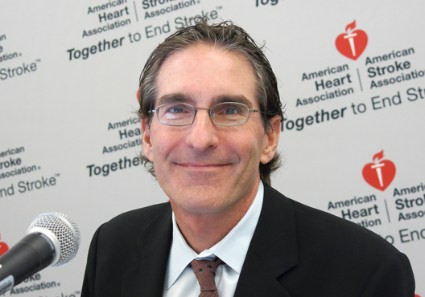User login
American Heart Association (AHA): International Stroke Conference
Magnesium for stroke failed but fast treatment feasible
SAN DIEGO – Having paramedics give intravenous magnesium to patients with acute stroke in the ambulance did not improve stroke-related disability 3 months later in a randomized, double-blind, placebo controlled trial of 1,700 patients.
Patients in both the magnesium and placebo groups had an average modified Rankin Scale score of 2.7, indicating slight to moderate levels of disability at 3 months.
But the negative results were balanced by the demonstration that stroke patients can receive potentially neuroprotective agents in the field, before arrival at a hospital, said Dr. Jeffrey L. Saver. The median time to treatment was 45 minutes after symptom onset and 74% of patients started treatment within an hour of symptoms, the "golden hour" when treatment may produce the best odds of survival and lowest odds of long-term neurological damage, he said at the International Stroke Conference. Another 25% of patients were treated within 1-2 hours of initial symptoms.
Already plans are underway to test other investigational therapies in the field, as researchers are encouraged by these results from the Field Administration of Stroke Therapy – Magnesium (FAST-MAG) trial, he said.
In a Danish trial, investigators are studying prehospital remote ischemic perconditioning for stroke patients. British and U.S. researchers are giving glyceryl trinitrate in the ambulance. Canadian researchers soon will start testing in-ambulance administration of NA-1, another potentially neuroprotective drug, said Dr. Saver, professor of neurology and director of the stroke center at the University of California, Los Angeles.
"We know that every minute that goes by without treatment, 2 million nerve cells are lost" after a stroke, he said at a press briefing.
The only approved treatment for strokes caused by clots is tissue plasminogen activator (TPA), which can’t be administered in ambulances because imaging studies are needed first to confirm a clot and avoid potentially harming patients with hemorrhagic stroke by giving them TPA.
The FAST-MAG study coordinated 315 ambulances, 40 emergency medical service agencies, 60 hospitals, and 2,988 paramedics in two California counties to evaluate 1,700 stroke patients in the field in 2005-2012 and begin IV treatment within 2 hours of symptom onset.
Patients aged 40-95 years with a likely stroke as identified by the Los Angeles Prehospital Stroke Screen received magnesium sulfate or matched saline placebo in the ambulance in a loading dose of 4 g over 15 minutes if they were within 2 hours of symptom onset and had neurological deficits present for 15 minutes or longer. When they arrived at the hospital, they received a maintenance infusion of 16 g magnesium or placebo over 24 hours.
"These were fairly severe stroke patients," with a mean pretreatment stroke severity score of 4 on the Los Angeles Motor Scale, which is roughly equivalent to a 13 on the National Institutes of Health Stroke Scale (NIHSS), he said at the conference, sponsored by the American Heart Association. They had a mean NIHSS score of 11 on arrival at emergency departments. The time from intake on the scene to the hospital door averaged 33 minutes, faster than an average 35 minutes in Los Angeles in prior data.
The final diagnoses included cerebral ischemia in 73% of patients, intracranial hemorrhage in 23%, and stroke mimics in 4%.
In six previous trials of neuroprotective agents in 5,345 patients, times from enrollment to treatment average longer than 3 hours in 92% of patients, 2-3 hours in 6%, 1-2 hours in 1%, and 0-1 hours in only 0.2% of patients, Dr. Saver said. (Percentages don’t equal 100% because of rounding.)
Overall rates of serious adverse events did not differ significantly between groups in the current study. The magnesium group had significantly higher rates of any respiratory complications (8% vs. 5%), hypotension (7% vs. 4%), and dyspnea or respiratory distress (4% vs. 2%), and a lower rate of neoplasms (1% vs. 2%), compared with the placebo group.
Previous animal studies found that IV magnesium dilated brain blood vessels and increased blood flow, and previous small trials in humans showed no overall harm or benefit but provided hints that magnesium might help if administered with a few hours of a stroke.
Dr. Saver reported having no financial disclosures. The trial was partly supported by the National Institute of Neurological Disorders and Stroke.
On Twitter @sherryboschert
SAN DIEGO – Having paramedics give intravenous magnesium to patients with acute stroke in the ambulance did not improve stroke-related disability 3 months later in a randomized, double-blind, placebo controlled trial of 1,700 patients.
Patients in both the magnesium and placebo groups had an average modified Rankin Scale score of 2.7, indicating slight to moderate levels of disability at 3 months.
But the negative results were balanced by the demonstration that stroke patients can receive potentially neuroprotective agents in the field, before arrival at a hospital, said Dr. Jeffrey L. Saver. The median time to treatment was 45 minutes after symptom onset and 74% of patients started treatment within an hour of symptoms, the "golden hour" when treatment may produce the best odds of survival and lowest odds of long-term neurological damage, he said at the International Stroke Conference. Another 25% of patients were treated within 1-2 hours of initial symptoms.
Already plans are underway to test other investigational therapies in the field, as researchers are encouraged by these results from the Field Administration of Stroke Therapy – Magnesium (FAST-MAG) trial, he said.
In a Danish trial, investigators are studying prehospital remote ischemic perconditioning for stroke patients. British and U.S. researchers are giving glyceryl trinitrate in the ambulance. Canadian researchers soon will start testing in-ambulance administration of NA-1, another potentially neuroprotective drug, said Dr. Saver, professor of neurology and director of the stroke center at the University of California, Los Angeles.
"We know that every minute that goes by without treatment, 2 million nerve cells are lost" after a stroke, he said at a press briefing.
The only approved treatment for strokes caused by clots is tissue plasminogen activator (TPA), which can’t be administered in ambulances because imaging studies are needed first to confirm a clot and avoid potentially harming patients with hemorrhagic stroke by giving them TPA.
The FAST-MAG study coordinated 315 ambulances, 40 emergency medical service agencies, 60 hospitals, and 2,988 paramedics in two California counties to evaluate 1,700 stroke patients in the field in 2005-2012 and begin IV treatment within 2 hours of symptom onset.
Patients aged 40-95 years with a likely stroke as identified by the Los Angeles Prehospital Stroke Screen received magnesium sulfate or matched saline placebo in the ambulance in a loading dose of 4 g over 15 minutes if they were within 2 hours of symptom onset and had neurological deficits present for 15 minutes or longer. When they arrived at the hospital, they received a maintenance infusion of 16 g magnesium or placebo over 24 hours.
"These were fairly severe stroke patients," with a mean pretreatment stroke severity score of 4 on the Los Angeles Motor Scale, which is roughly equivalent to a 13 on the National Institutes of Health Stroke Scale (NIHSS), he said at the conference, sponsored by the American Heart Association. They had a mean NIHSS score of 11 on arrival at emergency departments. The time from intake on the scene to the hospital door averaged 33 minutes, faster than an average 35 minutes in Los Angeles in prior data.
The final diagnoses included cerebral ischemia in 73% of patients, intracranial hemorrhage in 23%, and stroke mimics in 4%.
In six previous trials of neuroprotective agents in 5,345 patients, times from enrollment to treatment average longer than 3 hours in 92% of patients, 2-3 hours in 6%, 1-2 hours in 1%, and 0-1 hours in only 0.2% of patients, Dr. Saver said. (Percentages don’t equal 100% because of rounding.)
Overall rates of serious adverse events did not differ significantly between groups in the current study. The magnesium group had significantly higher rates of any respiratory complications (8% vs. 5%), hypotension (7% vs. 4%), and dyspnea or respiratory distress (4% vs. 2%), and a lower rate of neoplasms (1% vs. 2%), compared with the placebo group.
Previous animal studies found that IV magnesium dilated brain blood vessels and increased blood flow, and previous small trials in humans showed no overall harm or benefit but provided hints that magnesium might help if administered with a few hours of a stroke.
Dr. Saver reported having no financial disclosures. The trial was partly supported by the National Institute of Neurological Disorders and Stroke.
On Twitter @sherryboschert
SAN DIEGO – Having paramedics give intravenous magnesium to patients with acute stroke in the ambulance did not improve stroke-related disability 3 months later in a randomized, double-blind, placebo controlled trial of 1,700 patients.
Patients in both the magnesium and placebo groups had an average modified Rankin Scale score of 2.7, indicating slight to moderate levels of disability at 3 months.
But the negative results were balanced by the demonstration that stroke patients can receive potentially neuroprotective agents in the field, before arrival at a hospital, said Dr. Jeffrey L. Saver. The median time to treatment was 45 minutes after symptom onset and 74% of patients started treatment within an hour of symptoms, the "golden hour" when treatment may produce the best odds of survival and lowest odds of long-term neurological damage, he said at the International Stroke Conference. Another 25% of patients were treated within 1-2 hours of initial symptoms.
Already plans are underway to test other investigational therapies in the field, as researchers are encouraged by these results from the Field Administration of Stroke Therapy – Magnesium (FAST-MAG) trial, he said.
In a Danish trial, investigators are studying prehospital remote ischemic perconditioning for stroke patients. British and U.S. researchers are giving glyceryl trinitrate in the ambulance. Canadian researchers soon will start testing in-ambulance administration of NA-1, another potentially neuroprotective drug, said Dr. Saver, professor of neurology and director of the stroke center at the University of California, Los Angeles.
"We know that every minute that goes by without treatment, 2 million nerve cells are lost" after a stroke, he said at a press briefing.
The only approved treatment for strokes caused by clots is tissue plasminogen activator (TPA), which can’t be administered in ambulances because imaging studies are needed first to confirm a clot and avoid potentially harming patients with hemorrhagic stroke by giving them TPA.
The FAST-MAG study coordinated 315 ambulances, 40 emergency medical service agencies, 60 hospitals, and 2,988 paramedics in two California counties to evaluate 1,700 stroke patients in the field in 2005-2012 and begin IV treatment within 2 hours of symptom onset.
Patients aged 40-95 years with a likely stroke as identified by the Los Angeles Prehospital Stroke Screen received magnesium sulfate or matched saline placebo in the ambulance in a loading dose of 4 g over 15 minutes if they were within 2 hours of symptom onset and had neurological deficits present for 15 minutes or longer. When they arrived at the hospital, they received a maintenance infusion of 16 g magnesium or placebo over 24 hours.
"These were fairly severe stroke patients," with a mean pretreatment stroke severity score of 4 on the Los Angeles Motor Scale, which is roughly equivalent to a 13 on the National Institutes of Health Stroke Scale (NIHSS), he said at the conference, sponsored by the American Heart Association. They had a mean NIHSS score of 11 on arrival at emergency departments. The time from intake on the scene to the hospital door averaged 33 minutes, faster than an average 35 minutes in Los Angeles in prior data.
The final diagnoses included cerebral ischemia in 73% of patients, intracranial hemorrhage in 23%, and stroke mimics in 4%.
In six previous trials of neuroprotective agents in 5,345 patients, times from enrollment to treatment average longer than 3 hours in 92% of patients, 2-3 hours in 6%, 1-2 hours in 1%, and 0-1 hours in only 0.2% of patients, Dr. Saver said. (Percentages don’t equal 100% because of rounding.)
Overall rates of serious adverse events did not differ significantly between groups in the current study. The magnesium group had significantly higher rates of any respiratory complications (8% vs. 5%), hypotension (7% vs. 4%), and dyspnea or respiratory distress (4% vs. 2%), and a lower rate of neoplasms (1% vs. 2%), compared with the placebo group.
Previous animal studies found that IV magnesium dilated brain blood vessels and increased blood flow, and previous small trials in humans showed no overall harm or benefit but provided hints that magnesium might help if administered with a few hours of a stroke.
Dr. Saver reported having no financial disclosures. The trial was partly supported by the National Institute of Neurological Disorders and Stroke.
On Twitter @sherryboschert
AT THE INTERNATIONAL STROKE CONFERENCE
Major finding: Median time from stroke symptom onset to treatment was 45 minutes and 74% of patients started treatment within 1 hour, but disability scores at 3 months did not differ significantly between magnesium and placebo groups.
Data source: A multicenter, randomized, double-blind, placebo-controlled trial of IV magnesium or placebo given in the ambulance to 1,700 patients with a likely stroke.
Disclosures: Dr. Saver reported having no financial disclosures. The trial was partly supported by the National Institute of Neurological Disorders and Stroke.
Midpoint safety results for intraventricular hemorrhage thrombolysis trial promising
SAN DIEGO – The midpoint results of the CLEAR III trial that is investigating the safety and benefit of using recombinant tissue plasminogen activator to lyse intraventricular clots formed after intracerebral hemorrhage didn’t set off any safety alarms.
"The mortality, bleeding, and infection rates are lower than expected, indicating that the study protocol is safe for patients with severe intraventricular hemorrhage," said Dr. Wendy Ziai, chair of the trial’s safety event committee and the principal investigator of the trial at Johns Hopkins University, Baltimore, which is one of 70 sites involved in the trial.
There are currently very few treatments available for the treatment of intraventricular hemorrhage (IVH) and intracerebral hemorrhage (ICH). Clot lysis with recombinant tissue plasminogen activator (TPA) is one treatment option that has reached phase III, and it could have practice-changing implications, depending on the final results.
But for now, "we still don’t have enough information to change patient care," said Dr. Darin Zahuranec of the department of neurology at the University of Michigan, Ann Arbor. "These findings mean that we need to eagerly await the final results," said Dr. Zahuranec, who was not involved in the study.
The double-blind, randomized placebo-controlled CLEAR III trial (Clot Lysis: Evaluation of Accelerated Resolution of Interventricular Hemorrhage Phase III) is evaluating the benefit, safety, and best protocol for extraventricular drainage use plus 1-mg recombinant TPA (Alteplase) every 8 hours, in patients with IVH. The control group had extraventricular drainage in place, but received placebo.
The midpoint results, which included 250 patients in 61 centers, also showed that prophylactic heparin during and immediately after dosing may be associated with a higher risk of intracranial bleeding. Thrombotic events, however, may be more frequent in patients who were not receiving prophylaxis, said Dr. Ziai, who presented her findings at the International Stroke Conference, sponsored by the American Heart Association.
The CLEAR III trial monitored three prespecified safety endpoint thresholds: symptomatic hemorrhage within 72 hours of the agent, brain infections within 30 days of randomization, and 30-day mortality.
The results for all patients showed that there were 36 hemorrhages at 72 hours after the last dose of the study agent, 3 (1.2%) of which were symptomatic. Also, 22 (61%) of the hemorrhages occurred in the setting of prophylactic heparin.
Within 30 days of randomization, there were 60 brain hemorrhages in 44 patients at a rate of 17.5% (10% were symptomatic and 90% were asymptomatic). Mortality was 12.4%, bacterial ventriculitis was 2%, and nonbacterial ventriculitis was 5.2%.
"These are well below the [Data Safety Monitoring Board’s] safety thresholds," Dr. Ziai said.
Of 215 patients not on antiplatelet therapy prior to diagnosis, 15% had a bleeding event 72 hours after randomization, compared with 11% of the 35 patients who were on antiplatelet therapy. The association was not significant.
Also, of the 116 patients not on prophylactic heparin, 12% had a hemorrhagic event, compared with 16% of the 134 patients who were receiving the therapy, showing no significant association.
Meanwhile, 23% of the patients who were not on prophylactic heparin had a thrombotic event by day 30, while 9% of those on heparin had such an event (P = .005).
There were 259 severe adverse events within 1-year follow-up, 19 (7%) of which were possibly related to the study agent. Ventriculoperitoneal shunts were placed in 53 patients.
"It should be remembered that intraventricular rTPA is not currently the standard of care, and it’s hoped that CLEAR III trial will demonstrate the benefit and safety of this therapy," Dr. Ziai said. "The safety, however, cannot be achieved without strict protocols for stabilizing hemorrhages, concurrent drug use, and careful tracking of adverse events through an adjudication process."
Dr. Ziai and Dr. Zahuranec said they had no relevant financial disclosures. The study is funded by the National Institute of Neurological Disorders and Stroke.
On Twitter @naseemsmiller
SAN DIEGO – The midpoint results of the CLEAR III trial that is investigating the safety and benefit of using recombinant tissue plasminogen activator to lyse intraventricular clots formed after intracerebral hemorrhage didn’t set off any safety alarms.
"The mortality, bleeding, and infection rates are lower than expected, indicating that the study protocol is safe for patients with severe intraventricular hemorrhage," said Dr. Wendy Ziai, chair of the trial’s safety event committee and the principal investigator of the trial at Johns Hopkins University, Baltimore, which is one of 70 sites involved in the trial.
There are currently very few treatments available for the treatment of intraventricular hemorrhage (IVH) and intracerebral hemorrhage (ICH). Clot lysis with recombinant tissue plasminogen activator (TPA) is one treatment option that has reached phase III, and it could have practice-changing implications, depending on the final results.
But for now, "we still don’t have enough information to change patient care," said Dr. Darin Zahuranec of the department of neurology at the University of Michigan, Ann Arbor. "These findings mean that we need to eagerly await the final results," said Dr. Zahuranec, who was not involved in the study.
The double-blind, randomized placebo-controlled CLEAR III trial (Clot Lysis: Evaluation of Accelerated Resolution of Interventricular Hemorrhage Phase III) is evaluating the benefit, safety, and best protocol for extraventricular drainage use plus 1-mg recombinant TPA (Alteplase) every 8 hours, in patients with IVH. The control group had extraventricular drainage in place, but received placebo.
The midpoint results, which included 250 patients in 61 centers, also showed that prophylactic heparin during and immediately after dosing may be associated with a higher risk of intracranial bleeding. Thrombotic events, however, may be more frequent in patients who were not receiving prophylaxis, said Dr. Ziai, who presented her findings at the International Stroke Conference, sponsored by the American Heart Association.
The CLEAR III trial monitored three prespecified safety endpoint thresholds: symptomatic hemorrhage within 72 hours of the agent, brain infections within 30 days of randomization, and 30-day mortality.
The results for all patients showed that there were 36 hemorrhages at 72 hours after the last dose of the study agent, 3 (1.2%) of which were symptomatic. Also, 22 (61%) of the hemorrhages occurred in the setting of prophylactic heparin.
Within 30 days of randomization, there were 60 brain hemorrhages in 44 patients at a rate of 17.5% (10% were symptomatic and 90% were asymptomatic). Mortality was 12.4%, bacterial ventriculitis was 2%, and nonbacterial ventriculitis was 5.2%.
"These are well below the [Data Safety Monitoring Board’s] safety thresholds," Dr. Ziai said.
Of 215 patients not on antiplatelet therapy prior to diagnosis, 15% had a bleeding event 72 hours after randomization, compared with 11% of the 35 patients who were on antiplatelet therapy. The association was not significant.
Also, of the 116 patients not on prophylactic heparin, 12% had a hemorrhagic event, compared with 16% of the 134 patients who were receiving the therapy, showing no significant association.
Meanwhile, 23% of the patients who were not on prophylactic heparin had a thrombotic event by day 30, while 9% of those on heparin had such an event (P = .005).
There were 259 severe adverse events within 1-year follow-up, 19 (7%) of which were possibly related to the study agent. Ventriculoperitoneal shunts were placed in 53 patients.
"It should be remembered that intraventricular rTPA is not currently the standard of care, and it’s hoped that CLEAR III trial will demonstrate the benefit and safety of this therapy," Dr. Ziai said. "The safety, however, cannot be achieved without strict protocols for stabilizing hemorrhages, concurrent drug use, and careful tracking of adverse events through an adjudication process."
Dr. Ziai and Dr. Zahuranec said they had no relevant financial disclosures. The study is funded by the National Institute of Neurological Disorders and Stroke.
On Twitter @naseemsmiller
SAN DIEGO – The midpoint results of the CLEAR III trial that is investigating the safety and benefit of using recombinant tissue plasminogen activator to lyse intraventricular clots formed after intracerebral hemorrhage didn’t set off any safety alarms.
"The mortality, bleeding, and infection rates are lower than expected, indicating that the study protocol is safe for patients with severe intraventricular hemorrhage," said Dr. Wendy Ziai, chair of the trial’s safety event committee and the principal investigator of the trial at Johns Hopkins University, Baltimore, which is one of 70 sites involved in the trial.
There are currently very few treatments available for the treatment of intraventricular hemorrhage (IVH) and intracerebral hemorrhage (ICH). Clot lysis with recombinant tissue plasminogen activator (TPA) is one treatment option that has reached phase III, and it could have practice-changing implications, depending on the final results.
But for now, "we still don’t have enough information to change patient care," said Dr. Darin Zahuranec of the department of neurology at the University of Michigan, Ann Arbor. "These findings mean that we need to eagerly await the final results," said Dr. Zahuranec, who was not involved in the study.
The double-blind, randomized placebo-controlled CLEAR III trial (Clot Lysis: Evaluation of Accelerated Resolution of Interventricular Hemorrhage Phase III) is evaluating the benefit, safety, and best protocol for extraventricular drainage use plus 1-mg recombinant TPA (Alteplase) every 8 hours, in patients with IVH. The control group had extraventricular drainage in place, but received placebo.
The midpoint results, which included 250 patients in 61 centers, also showed that prophylactic heparin during and immediately after dosing may be associated with a higher risk of intracranial bleeding. Thrombotic events, however, may be more frequent in patients who were not receiving prophylaxis, said Dr. Ziai, who presented her findings at the International Stroke Conference, sponsored by the American Heart Association.
The CLEAR III trial monitored three prespecified safety endpoint thresholds: symptomatic hemorrhage within 72 hours of the agent, brain infections within 30 days of randomization, and 30-day mortality.
The results for all patients showed that there were 36 hemorrhages at 72 hours after the last dose of the study agent, 3 (1.2%) of which were symptomatic. Also, 22 (61%) of the hemorrhages occurred in the setting of prophylactic heparin.
Within 30 days of randomization, there were 60 brain hemorrhages in 44 patients at a rate of 17.5% (10% were symptomatic and 90% were asymptomatic). Mortality was 12.4%, bacterial ventriculitis was 2%, and nonbacterial ventriculitis was 5.2%.
"These are well below the [Data Safety Monitoring Board’s] safety thresholds," Dr. Ziai said.
Of 215 patients not on antiplatelet therapy prior to diagnosis, 15% had a bleeding event 72 hours after randomization, compared with 11% of the 35 patients who were on antiplatelet therapy. The association was not significant.
Also, of the 116 patients not on prophylactic heparin, 12% had a hemorrhagic event, compared with 16% of the 134 patients who were receiving the therapy, showing no significant association.
Meanwhile, 23% of the patients who were not on prophylactic heparin had a thrombotic event by day 30, while 9% of those on heparin had such an event (P = .005).
There were 259 severe adverse events within 1-year follow-up, 19 (7%) of which were possibly related to the study agent. Ventriculoperitoneal shunts were placed in 53 patients.
"It should be remembered that intraventricular rTPA is not currently the standard of care, and it’s hoped that CLEAR III trial will demonstrate the benefit and safety of this therapy," Dr. Ziai said. "The safety, however, cannot be achieved without strict protocols for stabilizing hemorrhages, concurrent drug use, and careful tracking of adverse events through an adjudication process."
Dr. Ziai and Dr. Zahuranec said they had no relevant financial disclosures. The study is funded by the National Institute of Neurological Disorders and Stroke.
On Twitter @naseemsmiller
AT THE INTERNATIONAL STROKE CONFERENCE
Major finding: Results showed that within 30 days, mortality was 12.4%, bacterial ventriculitis was 2%, and nonbacterial ventriculitis was 5.2%, all below the safety threshold.
Data source: Midpoint results of a phase III, double-blind, randomized placebo-controlled trial of 250 patients with IVH.
Disclosures: Dr. Ziai and Dr. Zahuranec said they had no relevant financial disclosures. The study is funded by the National Institute of Neurological Disorders and Stroke.
VIDEO: Expansion of intraventricular thrombolysis hinges on trial results
The midpoint results of the CLEAR III trial didn’t set off any safety alarms, as researchers continue to recruit patients, aiming to evaluate the safety and benefit of intraventricular recombinant tissue plasminogen activator.
"The mortality, bleeding, and infection rates are lower than expected, indicating that the study protocol is safe for patients with severe intraventricular hemorrhage," said Dr. Wendy Ziai, chair of the trial’s Safety Event Committee and the principal investigator of the trial at Johns Hopkins University, Baltimore, which is one of 70 sites involved in the trial.
In this video, watch Dr. Ziai speak more about the trial at the International Stroke Conference.
The video associated with this article is no longer available on this site. Please view all of our videos on the MDedge YouTube channel
On Twitter @naseemsmiller
The midpoint results of the CLEAR III trial didn’t set off any safety alarms, as researchers continue to recruit patients, aiming to evaluate the safety and benefit of intraventricular recombinant tissue plasminogen activator.
"The mortality, bleeding, and infection rates are lower than expected, indicating that the study protocol is safe for patients with severe intraventricular hemorrhage," said Dr. Wendy Ziai, chair of the trial’s Safety Event Committee and the principal investigator of the trial at Johns Hopkins University, Baltimore, which is one of 70 sites involved in the trial.
In this video, watch Dr. Ziai speak more about the trial at the International Stroke Conference.
The video associated with this article is no longer available on this site. Please view all of our videos on the MDedge YouTube channel
On Twitter @naseemsmiller
The midpoint results of the CLEAR III trial didn’t set off any safety alarms, as researchers continue to recruit patients, aiming to evaluate the safety and benefit of intraventricular recombinant tissue plasminogen activator.
"The mortality, bleeding, and infection rates are lower than expected, indicating that the study protocol is safe for patients with severe intraventricular hemorrhage," said Dr. Wendy Ziai, chair of the trial’s Safety Event Committee and the principal investigator of the trial at Johns Hopkins University, Baltimore, which is one of 70 sites involved in the trial.
In this video, watch Dr. Ziai speak more about the trial at the International Stroke Conference.
The video associated with this article is no longer available on this site. Please view all of our videos on the MDedge YouTube channel
On Twitter @naseemsmiller
Beta-blocker use associated with better outcomes after insular cortex infarcts
SAN DIEGO – Prior beta-blocker use may improve outcomes following insular ischemic strokes, according to a prospective, observational study of 1,014 consecutive stroke patients at Massachusetts General Hospital in Boston.
Favorable outcomes, defined by modified Rankin Scale (mRS) scores of 0-2 at 3 months – occurred with significantly greater likelihood among patients with infarcts of the insular or surrounding opercular cortex who used beta-blockers (BBs) within 24 hours before stroke onset, after researchers controlled for underlying cardiovascular and other risk factors on multivariate analysis (odds ratio, 2.21; 95% confidence interval, 1.03-4.75; P = .04).
"A lot of people have studied the effect" of BBs on stroke, and have found that "indiscriminate use in acute stroke patients is not beneficial, and may be associated with harm," said senior author Dr. Hakan Ay of the departments of neurology and radiology at Massachusetts General.
But previous studies lumped strokes together, regardless of infarct location. "This is the first study that links response to a specific brain site. What this tells us is if you find the right patient, you can get benefit" from BBs, although the finding must be confirmed by randomized trial, Dr. Ay said at the International Stroke Conference, sponsored by the American Heart Association.
The 402 BB users and 612 nonusers in the study, about evenly split between men and women, were admitted within 3 days of stroke onset.
BB patients were older (mean 74 years vs. 65 years) and more often had risk factors such as coronary artery disease (33% vs. 13%), atrial fibrillation (40% vs. 17%), and heart failure (12% vs. 4%).
The National Institutes of Health Stroke Scale score was higher in the BB group (mean 5 vs. 3). Twenty-three percent of BB patients and 18% of nonusers got intravenous thrombolysis (P = .06).
Overall, about two-thirds of patients in the study did well, with mRS scores of 0-2 at 3 months. BB patients did a bit worse, with just 57% achieving the score. Univariate analyses revealed a decreased probability of good outcome in the BB patients, as expected given their poorer baseline health (OR 0.72; 95% CI 0.55-0.93).
After adjustment for that baseline difference on multivariate analysis, prior BB use did not predict good or bad outcomes when all strokes were considered (OR 1.33; 95% CI 0.90-1.96; P = .16), which might indicate that while insular patients seemed to benefit, prior BB use may have contributed to worse outcomes in other stroke types, Dr. Ay said.
The benefit emerged when multivariate analysis was limited to BB patients and nonusers who had insular strokes. The investigators did not report how many were in each group.
There’s biological plausibility for the finding; insular injury is associated with autonomic dysregulation, leading to increases in blood pressure and other problems that likely affect outcomes. BBs might moderate the effect, Dr. Ay said.
The investigators had no relevant disclosures. The work was funded by the National Institute of Neurological Disorders and Stroke.
SAN DIEGO – Prior beta-blocker use may improve outcomes following insular ischemic strokes, according to a prospective, observational study of 1,014 consecutive stroke patients at Massachusetts General Hospital in Boston.
Favorable outcomes, defined by modified Rankin Scale (mRS) scores of 0-2 at 3 months – occurred with significantly greater likelihood among patients with infarcts of the insular or surrounding opercular cortex who used beta-blockers (BBs) within 24 hours before stroke onset, after researchers controlled for underlying cardiovascular and other risk factors on multivariate analysis (odds ratio, 2.21; 95% confidence interval, 1.03-4.75; P = .04).
"A lot of people have studied the effect" of BBs on stroke, and have found that "indiscriminate use in acute stroke patients is not beneficial, and may be associated with harm," said senior author Dr. Hakan Ay of the departments of neurology and radiology at Massachusetts General.
But previous studies lumped strokes together, regardless of infarct location. "This is the first study that links response to a specific brain site. What this tells us is if you find the right patient, you can get benefit" from BBs, although the finding must be confirmed by randomized trial, Dr. Ay said at the International Stroke Conference, sponsored by the American Heart Association.
The 402 BB users and 612 nonusers in the study, about evenly split between men and women, were admitted within 3 days of stroke onset.
BB patients were older (mean 74 years vs. 65 years) and more often had risk factors such as coronary artery disease (33% vs. 13%), atrial fibrillation (40% vs. 17%), and heart failure (12% vs. 4%).
The National Institutes of Health Stroke Scale score was higher in the BB group (mean 5 vs. 3). Twenty-three percent of BB patients and 18% of nonusers got intravenous thrombolysis (P = .06).
Overall, about two-thirds of patients in the study did well, with mRS scores of 0-2 at 3 months. BB patients did a bit worse, with just 57% achieving the score. Univariate analyses revealed a decreased probability of good outcome in the BB patients, as expected given their poorer baseline health (OR 0.72; 95% CI 0.55-0.93).
After adjustment for that baseline difference on multivariate analysis, prior BB use did not predict good or bad outcomes when all strokes were considered (OR 1.33; 95% CI 0.90-1.96; P = .16), which might indicate that while insular patients seemed to benefit, prior BB use may have contributed to worse outcomes in other stroke types, Dr. Ay said.
The benefit emerged when multivariate analysis was limited to BB patients and nonusers who had insular strokes. The investigators did not report how many were in each group.
There’s biological plausibility for the finding; insular injury is associated with autonomic dysregulation, leading to increases in blood pressure and other problems that likely affect outcomes. BBs might moderate the effect, Dr. Ay said.
The investigators had no relevant disclosures. The work was funded by the National Institute of Neurological Disorders and Stroke.
SAN DIEGO – Prior beta-blocker use may improve outcomes following insular ischemic strokes, according to a prospective, observational study of 1,014 consecutive stroke patients at Massachusetts General Hospital in Boston.
Favorable outcomes, defined by modified Rankin Scale (mRS) scores of 0-2 at 3 months – occurred with significantly greater likelihood among patients with infarcts of the insular or surrounding opercular cortex who used beta-blockers (BBs) within 24 hours before stroke onset, after researchers controlled for underlying cardiovascular and other risk factors on multivariate analysis (odds ratio, 2.21; 95% confidence interval, 1.03-4.75; P = .04).
"A lot of people have studied the effect" of BBs on stroke, and have found that "indiscriminate use in acute stroke patients is not beneficial, and may be associated with harm," said senior author Dr. Hakan Ay of the departments of neurology and radiology at Massachusetts General.
But previous studies lumped strokes together, regardless of infarct location. "This is the first study that links response to a specific brain site. What this tells us is if you find the right patient, you can get benefit" from BBs, although the finding must be confirmed by randomized trial, Dr. Ay said at the International Stroke Conference, sponsored by the American Heart Association.
The 402 BB users and 612 nonusers in the study, about evenly split between men and women, were admitted within 3 days of stroke onset.
BB patients were older (mean 74 years vs. 65 years) and more often had risk factors such as coronary artery disease (33% vs. 13%), atrial fibrillation (40% vs. 17%), and heart failure (12% vs. 4%).
The National Institutes of Health Stroke Scale score was higher in the BB group (mean 5 vs. 3). Twenty-three percent of BB patients and 18% of nonusers got intravenous thrombolysis (P = .06).
Overall, about two-thirds of patients in the study did well, with mRS scores of 0-2 at 3 months. BB patients did a bit worse, with just 57% achieving the score. Univariate analyses revealed a decreased probability of good outcome in the BB patients, as expected given their poorer baseline health (OR 0.72; 95% CI 0.55-0.93).
After adjustment for that baseline difference on multivariate analysis, prior BB use did not predict good or bad outcomes when all strokes were considered (OR 1.33; 95% CI 0.90-1.96; P = .16), which might indicate that while insular patients seemed to benefit, prior BB use may have contributed to worse outcomes in other stroke types, Dr. Ay said.
The benefit emerged when multivariate analysis was limited to BB patients and nonusers who had insular strokes. The investigators did not report how many were in each group.
There’s biological plausibility for the finding; insular injury is associated with autonomic dysregulation, leading to increases in blood pressure and other problems that likely affect outcomes. BBs might moderate the effect, Dr. Ay said.
The investigators had no relevant disclosures. The work was funded by the National Institute of Neurological Disorders and Stroke.
AT THE INTERNATIONAL STROKE CONFERENCE
Major finding: Beta-blocker use within 24 hours before stroke onset significantly predicts favorable outcomes in patients with infarcts of the insular or surrounding opercular cortex (odds ratio, 2.21; 95% confidence interval, 1.03-4.75; P = .04).
Data Source: Prospective, observational study of 1,014 consecutive stroke patients
Disclosures: The investigators had no relevant disclosures. The work was funded by the National Institute of Neurological Disorders and Stroke.
VIDEO: Device detects more atrial fibrillation, but when is intervention necessary?
SAN DIEGO – After 6 months, Medtronic’s Reveal XT implant picked up atrial fibrillation in 8.6% of cryptogenic stroke patients. Standard monitoring found it in 1.4%, according to company data presented at the International Stroke Conference. Devices from Medtronic and other companies are going to make detection of asymptomatic atrial fibrillation more common, raising questions about when to intervene. Cardiologist Rod Passman, an investigator for the company, and neurologist Steven Greenberg shared their thoughts on the issue.
The video associated with this article is no longer available on this site. Please view all of our videos on the MDedge YouTube channel
SAN DIEGO – After 6 months, Medtronic’s Reveal XT implant picked up atrial fibrillation in 8.6% of cryptogenic stroke patients. Standard monitoring found it in 1.4%, according to company data presented at the International Stroke Conference. Devices from Medtronic and other companies are going to make detection of asymptomatic atrial fibrillation more common, raising questions about when to intervene. Cardiologist Rod Passman, an investigator for the company, and neurologist Steven Greenberg shared their thoughts on the issue.
The video associated with this article is no longer available on this site. Please view all of our videos on the MDedge YouTube channel
SAN DIEGO – After 6 months, Medtronic’s Reveal XT implant picked up atrial fibrillation in 8.6% of cryptogenic stroke patients. Standard monitoring found it in 1.4%, according to company data presented at the International Stroke Conference. Devices from Medtronic and other companies are going to make detection of asymptomatic atrial fibrillation more common, raising questions about when to intervene. Cardiologist Rod Passman, an investigator for the company, and neurologist Steven Greenberg shared their thoughts on the issue.
The video associated with this article is no longer available on this site. Please view all of our videos on the MDedge YouTube channel
AT THE INTERNATIONAL STROKE CONFERENCE
Continuous AF monitors raise questions about when to intervene
SAN DIEGO – Medtronic’s Reveal XT heart monitor implant detected atrial fibrillation missed by older techniques in a randomized trial.
The company’s North American and European CRYSTAL-AF (Cryptogenic Stroke and Underlying Atrial Fibrillation) trial randomized 221 patients to the device after cryptogenic ischemic strokes or, less commonly, transient ischemic attacks, and 220 others to usual monitoring with ECGs or 24-hour Holter monitors. The Reveal XT device, about the size of a computer thumb drive, is slipped under the flesh on the left side of the chest with local anesthesia, and transmits data wirelessly.
After 6 months, the device picked up atrial fibrillation (AF) in 19 patients (8.6%). Standard monitoring detected AF in three patients, or 1.4% (hazard ratio, 6.4; 95% confidence interval, 1.9-21.7; P = .0006).
Fourteen (74%) Reveal XT AF patients were asymptomatic, and 18 (94.7%) were switched from antiplatelet therapy to oral anticoagulants. One control group AF patient was asymptomatic, and two were switched to oral anticoagulants. Every patient in the trial was eligible for anticoagulants because of past embolic events and subsequent CHADS2 scores of 2 or more, but few were on anticoagulants when the trial started.
It’s probably not a surprise that Reveal XT and other modern implantable devices are good at finding AF, but it’s less clear sometimes about how to handle it. The investigators did not report the frequency of AF or the number of strokes, deaths, and anticoagulation complications in the trial.
"If someone had a stroke, and then is found to have AF, it’s hard to ignore that," said presenter and investigator Dr. Rod Passman, a cardiologist and professor of medicine at Northwestern University in Chicago.
There may be less to worry about with younger patients and those with few stroke risks. The mean age in the trial was 62 years, and most of the subjects were men.
However, "we are learning that anticoagulation is effective" in high-risk patients. "The studies were done on patients with a lot of AF, but even small episodes may increase the long-term stroke risk. We are not clear about what the threshold is, but I do think we are honing in [on it]. The question will be if there’s a subgroup at a particularly high risk," he said at the International Stroke Conference, sponsored by the American Heart Association.
After a year, Reveal XT had detected AF in 29 patients (13.1%), most of them asymptomatic. Standard monitoring found AF in four (1.8%), two of whom were asymptomatic (HR, 7.3; 95% CI, 2.6-20.8; P less than .0001). Detecting AF in the four control arm patients took 121 ECGs, 32 Holter monitors, and one event recorder. Almost all of the AF patients in both groups were switched to anticoagulants.
About 27 (93%) of the device AF patients had a maximum 1-day AF duration of more than 6 minutes; about 13 (45%) had episodes of 12-24 hours.
The device continued to outperform older methods at 3 years, the life of its battery (HR, 8.8; 95% CI, 3.5-22.2; P less than .0001).
It was taken out of five patients (2.3%) because of infections or pocket erosions.
Dr. Passman reported payments from Medtronic to work on the trial and significant research grants and speakers’ bureau and consultant fees from the company. The other 11 investigators disclosed personal payments from the company. Three were Medtronic employees. The company funded the trial.

|
|
Long-term cardiac monitoring is coming into play, and [overtreatment of atrial fibrillation] is a legitimate concern. There’re many questions about where to draw the line between risks and benefits.
But a lot of people in this trial had episodes lasting 12-24 hours, so the probability is high that AF caused their initial stroke. If it turns out that continual monitoring identifies AF cases with the same high stroke risk as the much smaller group we are picking up now, the implications are enormous because we have effective treatments: oral anticoagulants.
Dr. Steven Greenberg is a professor of neurology at Harvard Medical School in Boston. He said he had no relevant financial disclosures.

|
|
Long-term cardiac monitoring is coming into play, and [overtreatment of atrial fibrillation] is a legitimate concern. There’re many questions about where to draw the line between risks and benefits.
But a lot of people in this trial had episodes lasting 12-24 hours, so the probability is high that AF caused their initial stroke. If it turns out that continual monitoring identifies AF cases with the same high stroke risk as the much smaller group we are picking up now, the implications are enormous because we have effective treatments: oral anticoagulants.
Dr. Steven Greenberg is a professor of neurology at Harvard Medical School in Boston. He said he had no relevant financial disclosures.

|
|
Long-term cardiac monitoring is coming into play, and [overtreatment of atrial fibrillation] is a legitimate concern. There’re many questions about where to draw the line between risks and benefits.
But a lot of people in this trial had episodes lasting 12-24 hours, so the probability is high that AF caused their initial stroke. If it turns out that continual monitoring identifies AF cases with the same high stroke risk as the much smaller group we are picking up now, the implications are enormous because we have effective treatments: oral anticoagulants.
Dr. Steven Greenberg is a professor of neurology at Harvard Medical School in Boston. He said he had no relevant financial disclosures.
SAN DIEGO – Medtronic’s Reveal XT heart monitor implant detected atrial fibrillation missed by older techniques in a randomized trial.
The company’s North American and European CRYSTAL-AF (Cryptogenic Stroke and Underlying Atrial Fibrillation) trial randomized 221 patients to the device after cryptogenic ischemic strokes or, less commonly, transient ischemic attacks, and 220 others to usual monitoring with ECGs or 24-hour Holter monitors. The Reveal XT device, about the size of a computer thumb drive, is slipped under the flesh on the left side of the chest with local anesthesia, and transmits data wirelessly.
After 6 months, the device picked up atrial fibrillation (AF) in 19 patients (8.6%). Standard monitoring detected AF in three patients, or 1.4% (hazard ratio, 6.4; 95% confidence interval, 1.9-21.7; P = .0006).
Fourteen (74%) Reveal XT AF patients were asymptomatic, and 18 (94.7%) were switched from antiplatelet therapy to oral anticoagulants. One control group AF patient was asymptomatic, and two were switched to oral anticoagulants. Every patient in the trial was eligible for anticoagulants because of past embolic events and subsequent CHADS2 scores of 2 or more, but few were on anticoagulants when the trial started.
It’s probably not a surprise that Reveal XT and other modern implantable devices are good at finding AF, but it’s less clear sometimes about how to handle it. The investigators did not report the frequency of AF or the number of strokes, deaths, and anticoagulation complications in the trial.
"If someone had a stroke, and then is found to have AF, it’s hard to ignore that," said presenter and investigator Dr. Rod Passman, a cardiologist and professor of medicine at Northwestern University in Chicago.
There may be less to worry about with younger patients and those with few stroke risks. The mean age in the trial was 62 years, and most of the subjects were men.
However, "we are learning that anticoagulation is effective" in high-risk patients. "The studies were done on patients with a lot of AF, but even small episodes may increase the long-term stroke risk. We are not clear about what the threshold is, but I do think we are honing in [on it]. The question will be if there’s a subgroup at a particularly high risk," he said at the International Stroke Conference, sponsored by the American Heart Association.
After a year, Reveal XT had detected AF in 29 patients (13.1%), most of them asymptomatic. Standard monitoring found AF in four (1.8%), two of whom were asymptomatic (HR, 7.3; 95% CI, 2.6-20.8; P less than .0001). Detecting AF in the four control arm patients took 121 ECGs, 32 Holter monitors, and one event recorder. Almost all of the AF patients in both groups were switched to anticoagulants.
About 27 (93%) of the device AF patients had a maximum 1-day AF duration of more than 6 minutes; about 13 (45%) had episodes of 12-24 hours.
The device continued to outperform older methods at 3 years, the life of its battery (HR, 8.8; 95% CI, 3.5-22.2; P less than .0001).
It was taken out of five patients (2.3%) because of infections or pocket erosions.
Dr. Passman reported payments from Medtronic to work on the trial and significant research grants and speakers’ bureau and consultant fees from the company. The other 11 investigators disclosed personal payments from the company. Three were Medtronic employees. The company funded the trial.
SAN DIEGO – Medtronic’s Reveal XT heart monitor implant detected atrial fibrillation missed by older techniques in a randomized trial.
The company’s North American and European CRYSTAL-AF (Cryptogenic Stroke and Underlying Atrial Fibrillation) trial randomized 221 patients to the device after cryptogenic ischemic strokes or, less commonly, transient ischemic attacks, and 220 others to usual monitoring with ECGs or 24-hour Holter monitors. The Reveal XT device, about the size of a computer thumb drive, is slipped under the flesh on the left side of the chest with local anesthesia, and transmits data wirelessly.
After 6 months, the device picked up atrial fibrillation (AF) in 19 patients (8.6%). Standard monitoring detected AF in three patients, or 1.4% (hazard ratio, 6.4; 95% confidence interval, 1.9-21.7; P = .0006).
Fourteen (74%) Reveal XT AF patients were asymptomatic, and 18 (94.7%) were switched from antiplatelet therapy to oral anticoagulants. One control group AF patient was asymptomatic, and two were switched to oral anticoagulants. Every patient in the trial was eligible for anticoagulants because of past embolic events and subsequent CHADS2 scores of 2 or more, but few were on anticoagulants when the trial started.
It’s probably not a surprise that Reveal XT and other modern implantable devices are good at finding AF, but it’s less clear sometimes about how to handle it. The investigators did not report the frequency of AF or the number of strokes, deaths, and anticoagulation complications in the trial.
"If someone had a stroke, and then is found to have AF, it’s hard to ignore that," said presenter and investigator Dr. Rod Passman, a cardiologist and professor of medicine at Northwestern University in Chicago.
There may be less to worry about with younger patients and those with few stroke risks. The mean age in the trial was 62 years, and most of the subjects were men.
However, "we are learning that anticoagulation is effective" in high-risk patients. "The studies were done on patients with a lot of AF, but even small episodes may increase the long-term stroke risk. We are not clear about what the threshold is, but I do think we are honing in [on it]. The question will be if there’s a subgroup at a particularly high risk," he said at the International Stroke Conference, sponsored by the American Heart Association.
After a year, Reveal XT had detected AF in 29 patients (13.1%), most of them asymptomatic. Standard monitoring found AF in four (1.8%), two of whom were asymptomatic (HR, 7.3; 95% CI, 2.6-20.8; P less than .0001). Detecting AF in the four control arm patients took 121 ECGs, 32 Holter monitors, and one event recorder. Almost all of the AF patients in both groups were switched to anticoagulants.
About 27 (93%) of the device AF patients had a maximum 1-day AF duration of more than 6 minutes; about 13 (45%) had episodes of 12-24 hours.
The device continued to outperform older methods at 3 years, the life of its battery (HR, 8.8; 95% CI, 3.5-22.2; P less than .0001).
It was taken out of five patients (2.3%) because of infections or pocket erosions.
Dr. Passman reported payments from Medtronic to work on the trial and significant research grants and speakers’ bureau and consultant fees from the company. The other 11 investigators disclosed personal payments from the company. Three were Medtronic employees. The company funded the trial.
AT THE INTERNATIONAL STROKE CONFERENCE
Major finding: After 6 months, Medtronic’s Reveal XT heart monitor implant detected atrial fibrillation in 19 patients (8.6%). Standard monitoring detected AF in three (1.4%).
Data Source: A randomized prospective trial in mostly cryptogenic stroke patients.
Disclosures: The presenter, also an investigator, reported payments from Medtronic to work on the trial, and significant research grants and speakers’ bureau and consultant fees from the company. The other 11 investigators disclosed personal payments from the company. Three of the authors are employed by Medtronic. The company funded the trial.
VIDEO: Drug cocktail beats single agent in subarachnoid hemorrhage vasospasm treatment
SAN DIEGO - An intra-arterial infusion drug cocktail of nicardipine, verapamil, and nitroglycerin appears to work better than nicardipine or verapamil alone – the usual approach – to open up cerebral vasospasms after subarachnoid hemorrhage. The early results are so promising that lead investigator Dr. Peng Roc Chen, a cerebrovascular neurosurgeon at the University of Texas, Houston, and his colleagues are following up with a randomized controlled trial. Dr. Chen explained the project to us at this year’s International Stroke Conference.
The video associated with this article is no longer available on this site. Please view all of our videos on the MDedge YouTube channel
SAN DIEGO - An intra-arterial infusion drug cocktail of nicardipine, verapamil, and nitroglycerin appears to work better than nicardipine or verapamil alone – the usual approach – to open up cerebral vasospasms after subarachnoid hemorrhage. The early results are so promising that lead investigator Dr. Peng Roc Chen, a cerebrovascular neurosurgeon at the University of Texas, Houston, and his colleagues are following up with a randomized controlled trial. Dr. Chen explained the project to us at this year’s International Stroke Conference.
The video associated with this article is no longer available on this site. Please view all of our videos on the MDedge YouTube channel
SAN DIEGO - An intra-arterial infusion drug cocktail of nicardipine, verapamil, and nitroglycerin appears to work better than nicardipine or verapamil alone – the usual approach – to open up cerebral vasospasms after subarachnoid hemorrhage. The early results are so promising that lead investigator Dr. Peng Roc Chen, a cerebrovascular neurosurgeon at the University of Texas, Houston, and his colleagues are following up with a randomized controlled trial. Dr. Chen explained the project to us at this year’s International Stroke Conference.
The video associated with this article is no longer available on this site. Please view all of our videos on the MDedge YouTube channel
Vasodilator cocktail beats single-agent infusion for subarachnoid hemorrhage vasospasm
SAN DIEGO – Cerebral vasospasms open up, on average, 34.9% more when patients are infused with an intra-arterial cocktail of nicardipine, verapamil, and nitroglycerin, instead of the usual approach of nicardipine or verapamil alone, according to a retrospective study from the University of Texas, Houston.
Investigators there compared the cocktail to single-agent infusions in patients with vasospasms due to aneurysmal subarachnoid hemorrhages, after the offending aneurysms had been clipped or coiled.
Fifty-four patients with 116 spasmed vessels were infused with verapamil 10 mg or nicardipine 5 mg per vascular territory. Another 50 patients with 106 spasmed vessels were infused with verapamil 10 mg, nicardipine 5 mg, and nitroglycerin 200 mcg per vascular territory. The patients underwent repeat cerebral angiography at least 15 minutes after treatment.
In addition to having greater average dilation, the cocktail group had significantly greater improvement in the ratio of arterial lumen diameter before and after treatment than did the single-agent group (45.8% vs. 10.9%, respectively). The effect was independent of age.
There was a trend toward more modified Rankin Scale (mRS) scores of 0-2 in the multiple-agent group, but it was not statistically significant. Lead investigator Dr. Peng Roc Chen, a cerebrovascular neurosurgeon at the University of Texas, Houston, has launched a prospective randomized trial with his colleagues to investigate the matter further. Nine medical centers have signed up so far, and they are looking for more.
Single-agent infusion is standard practice in the United States, usually with verapamil, but it doesn’t work well, "and there’s no conclusive literature suggesting the best intra-arterial infusion regimen for vasospasm, particularly when balloon angioplasty is not feasible," Dr. Chen said at the International Stroke Conference, sponsored by the American Heart Association.
The team hoped for synergistic effects by combining commonly used intra-arterial vasodilators with different mechanisms of action, while avoiding the cardiovascular instability that comes with high-dose infusion of single agents. Verapamil and nicardipine are both calcium-channel blockers, but they work on different receptors, he said.
At discharge, 24 (44.4%) patients in the single-agent group had an mRS score of 0-2, 28 (51.9%) had an mRS score of 3-5, and 2 (3.7%) had died. At 3 months, 25 of the 34 patients not lost to follow-up (73.5%) had an mRS score of 0-2, seven (20.6%) had an mRS score of 3-5, and 2 (5.9%) had died.
In the multiagent group, 31 (62%) had an mRS score of 0-2 at discharge, 16 (32%) had an mRS score of 3-5, and 3 patients (6%) had died. At 3 months, 29 of the 36 patients not lost to follow-up (80.6%) had an mRS score of 0-2, 4 (11.1%) had an mRS score of 3-5, and 3 (8.3%) had died.
Small numbers and follow-up loss may have contributed to the lack of outcome significance. It’s also possible that subarachnoid hemorrhage drove outcomes, regardless of vasospasm treatment. In any case, multiagent infusion is now the standard approach at Dr. Chen’s medical center; the single-agent patients were historical controls, he said.
Sixteen (29.6%) patients in the single-agent arm needed additional treatment, either repeat infusions or balloon angioplasties. Twenty-two (44%) needed additional treatment in the multiple-agent group (P = .128).
Dr. Chen did not report patient demographics, but said there were no differences in post-treatment blood pressures, heart rate changes, or intracranial pressures between the two treatment groups. Patients who had balloon angioplasties before vasodilation were excluded from the study.
Verapamil and nicardipine were infused at a rate of 1 mg/min and nitroglycerin, at a rate of 100 mcg/min. In the single-agent arm, the investigators found no differences in vessel diameter change between verapamil and nicardipine.
The investigators reported having no relevant financial disclosures.
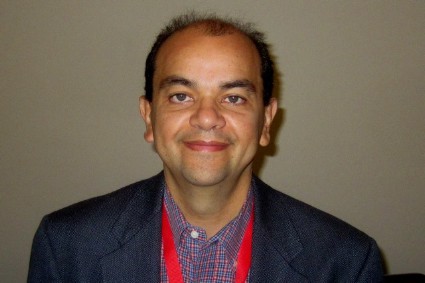
|
|
We’ve been learning that combining therapies seems to be better than giving a single agent. Whether this will translate into something we’ll be using down the line remains to be seen. We have to look at the safety of giving the three together. There’s a possibility, perhaps, that you could increase the diameter of the vessel too much, to the point where the patient will have edema, or you drop the pressure too much. Those issues may not have been picked up retrospectively.
Dr. Jose Suarez is head of the section of vascular neurology and neurocritical care at Baylor College of Medicine, Houston. He reported having no relevant financial disclosures.

|
|
We’ve been learning that combining therapies seems to be better than giving a single agent. Whether this will translate into something we’ll be using down the line remains to be seen. We have to look at the safety of giving the three together. There’s a possibility, perhaps, that you could increase the diameter of the vessel too much, to the point where the patient will have edema, or you drop the pressure too much. Those issues may not have been picked up retrospectively.
Dr. Jose Suarez is head of the section of vascular neurology and neurocritical care at Baylor College of Medicine, Houston. He reported having no relevant financial disclosures.

|
|
We’ve been learning that combining therapies seems to be better than giving a single agent. Whether this will translate into something we’ll be using down the line remains to be seen. We have to look at the safety of giving the three together. There’s a possibility, perhaps, that you could increase the diameter of the vessel too much, to the point where the patient will have edema, or you drop the pressure too much. Those issues may not have been picked up retrospectively.
Dr. Jose Suarez is head of the section of vascular neurology and neurocritical care at Baylor College of Medicine, Houston. He reported having no relevant financial disclosures.
SAN DIEGO – Cerebral vasospasms open up, on average, 34.9% more when patients are infused with an intra-arterial cocktail of nicardipine, verapamil, and nitroglycerin, instead of the usual approach of nicardipine or verapamil alone, according to a retrospective study from the University of Texas, Houston.
Investigators there compared the cocktail to single-agent infusions in patients with vasospasms due to aneurysmal subarachnoid hemorrhages, after the offending aneurysms had been clipped or coiled.
Fifty-four patients with 116 spasmed vessels were infused with verapamil 10 mg or nicardipine 5 mg per vascular territory. Another 50 patients with 106 spasmed vessels were infused with verapamil 10 mg, nicardipine 5 mg, and nitroglycerin 200 mcg per vascular territory. The patients underwent repeat cerebral angiography at least 15 minutes after treatment.
In addition to having greater average dilation, the cocktail group had significantly greater improvement in the ratio of arterial lumen diameter before and after treatment than did the single-agent group (45.8% vs. 10.9%, respectively). The effect was independent of age.
There was a trend toward more modified Rankin Scale (mRS) scores of 0-2 in the multiple-agent group, but it was not statistically significant. Lead investigator Dr. Peng Roc Chen, a cerebrovascular neurosurgeon at the University of Texas, Houston, has launched a prospective randomized trial with his colleagues to investigate the matter further. Nine medical centers have signed up so far, and they are looking for more.
Single-agent infusion is standard practice in the United States, usually with verapamil, but it doesn’t work well, "and there’s no conclusive literature suggesting the best intra-arterial infusion regimen for vasospasm, particularly when balloon angioplasty is not feasible," Dr. Chen said at the International Stroke Conference, sponsored by the American Heart Association.
The team hoped for synergistic effects by combining commonly used intra-arterial vasodilators with different mechanisms of action, while avoiding the cardiovascular instability that comes with high-dose infusion of single agents. Verapamil and nicardipine are both calcium-channel blockers, but they work on different receptors, he said.
At discharge, 24 (44.4%) patients in the single-agent group had an mRS score of 0-2, 28 (51.9%) had an mRS score of 3-5, and 2 (3.7%) had died. At 3 months, 25 of the 34 patients not lost to follow-up (73.5%) had an mRS score of 0-2, seven (20.6%) had an mRS score of 3-5, and 2 (5.9%) had died.
In the multiagent group, 31 (62%) had an mRS score of 0-2 at discharge, 16 (32%) had an mRS score of 3-5, and 3 patients (6%) had died. At 3 months, 29 of the 36 patients not lost to follow-up (80.6%) had an mRS score of 0-2, 4 (11.1%) had an mRS score of 3-5, and 3 (8.3%) had died.
Small numbers and follow-up loss may have contributed to the lack of outcome significance. It’s also possible that subarachnoid hemorrhage drove outcomes, regardless of vasospasm treatment. In any case, multiagent infusion is now the standard approach at Dr. Chen’s medical center; the single-agent patients were historical controls, he said.
Sixteen (29.6%) patients in the single-agent arm needed additional treatment, either repeat infusions or balloon angioplasties. Twenty-two (44%) needed additional treatment in the multiple-agent group (P = .128).
Dr. Chen did not report patient demographics, but said there were no differences in post-treatment blood pressures, heart rate changes, or intracranial pressures between the two treatment groups. Patients who had balloon angioplasties before vasodilation were excluded from the study.
Verapamil and nicardipine were infused at a rate of 1 mg/min and nitroglycerin, at a rate of 100 mcg/min. In the single-agent arm, the investigators found no differences in vessel diameter change between verapamil and nicardipine.
The investigators reported having no relevant financial disclosures.
SAN DIEGO – Cerebral vasospasms open up, on average, 34.9% more when patients are infused with an intra-arterial cocktail of nicardipine, verapamil, and nitroglycerin, instead of the usual approach of nicardipine or verapamil alone, according to a retrospective study from the University of Texas, Houston.
Investigators there compared the cocktail to single-agent infusions in patients with vasospasms due to aneurysmal subarachnoid hemorrhages, after the offending aneurysms had been clipped or coiled.
Fifty-four patients with 116 spasmed vessels were infused with verapamil 10 mg or nicardipine 5 mg per vascular territory. Another 50 patients with 106 spasmed vessels were infused with verapamil 10 mg, nicardipine 5 mg, and nitroglycerin 200 mcg per vascular territory. The patients underwent repeat cerebral angiography at least 15 minutes after treatment.
In addition to having greater average dilation, the cocktail group had significantly greater improvement in the ratio of arterial lumen diameter before and after treatment than did the single-agent group (45.8% vs. 10.9%, respectively). The effect was independent of age.
There was a trend toward more modified Rankin Scale (mRS) scores of 0-2 in the multiple-agent group, but it was not statistically significant. Lead investigator Dr. Peng Roc Chen, a cerebrovascular neurosurgeon at the University of Texas, Houston, has launched a prospective randomized trial with his colleagues to investigate the matter further. Nine medical centers have signed up so far, and they are looking for more.
Single-agent infusion is standard practice in the United States, usually with verapamil, but it doesn’t work well, "and there’s no conclusive literature suggesting the best intra-arterial infusion regimen for vasospasm, particularly when balloon angioplasty is not feasible," Dr. Chen said at the International Stroke Conference, sponsored by the American Heart Association.
The team hoped for synergistic effects by combining commonly used intra-arterial vasodilators with different mechanisms of action, while avoiding the cardiovascular instability that comes with high-dose infusion of single agents. Verapamil and nicardipine are both calcium-channel blockers, but they work on different receptors, he said.
At discharge, 24 (44.4%) patients in the single-agent group had an mRS score of 0-2, 28 (51.9%) had an mRS score of 3-5, and 2 (3.7%) had died. At 3 months, 25 of the 34 patients not lost to follow-up (73.5%) had an mRS score of 0-2, seven (20.6%) had an mRS score of 3-5, and 2 (5.9%) had died.
In the multiagent group, 31 (62%) had an mRS score of 0-2 at discharge, 16 (32%) had an mRS score of 3-5, and 3 patients (6%) had died. At 3 months, 29 of the 36 patients not lost to follow-up (80.6%) had an mRS score of 0-2, 4 (11.1%) had an mRS score of 3-5, and 3 (8.3%) had died.
Small numbers and follow-up loss may have contributed to the lack of outcome significance. It’s also possible that subarachnoid hemorrhage drove outcomes, regardless of vasospasm treatment. In any case, multiagent infusion is now the standard approach at Dr. Chen’s medical center; the single-agent patients were historical controls, he said.
Sixteen (29.6%) patients in the single-agent arm needed additional treatment, either repeat infusions or balloon angioplasties. Twenty-two (44%) needed additional treatment in the multiple-agent group (P = .128).
Dr. Chen did not report patient demographics, but said there were no differences in post-treatment blood pressures, heart rate changes, or intracranial pressures between the two treatment groups. Patients who had balloon angioplasties before vasodilation were excluded from the study.
Verapamil and nicardipine were infused at a rate of 1 mg/min and nitroglycerin, at a rate of 100 mcg/min. In the single-agent arm, the investigators found no differences in vessel diameter change between verapamil and nicardipine.
The investigators reported having no relevant financial disclosures.
AT THE INTERNATIONAL STROKE CONFERENCE
Major finding: Patients who received nicardipine, verapamil, and nitroglycerin had significantly greater improvement in the ratio of arterial lumen diameter before and after treatment than did those who received verapamil or nicardipine alone (45.8% vs. 10.9%, respectively).
Data Source: A retrospective study of 50 patients infused with an intra-arterial vasodilator cocktail and 54 infused with verapamil or nicardipine.
Disclosures: The investigators reported having no relevant financial disclosures.
.
VIDEO: 'Target: Stroke' program hopes to add hospitals, increase timely treatment
SAN DIEGO – The average proportion of ischemic patients who got tissue plasminogen activator within an hour of arriving at participating hospitals increased from 30% before initiation of the Target: Stroke project to 53% afterward. We interviewed Dr. Gregg C. Fonarow about the new phase II of Target: Stroke, launched at the International Stroke Conference, which aims for timely door-to-needle treatment in 75% of stroke patients.
The video associated with this article is no longer available on this site. Please view all of our videos on the MDedge YouTube channel
SAN DIEGO – The average proportion of ischemic patients who got tissue plasminogen activator within an hour of arriving at participating hospitals increased from 30% before initiation of the Target: Stroke project to 53% afterward. We interviewed Dr. Gregg C. Fonarow about the new phase II of Target: Stroke, launched at the International Stroke Conference, which aims for timely door-to-needle treatment in 75% of stroke patients.
The video associated with this article is no longer available on this site. Please view all of our videos on the MDedge YouTube channel
SAN DIEGO – The average proportion of ischemic patients who got tissue plasminogen activator within an hour of arriving at participating hospitals increased from 30% before initiation of the Target: Stroke project to 53% afterward. We interviewed Dr. Gregg C. Fonarow about the new phase II of Target: Stroke, launched at the International Stroke Conference, which aims for timely door-to-needle treatment in 75% of stroke patients.
The video associated with this article is no longer available on this site. Please view all of our videos on the MDedge YouTube channel
'Target: Stroke' program gets most patients timely treatment
SAN DIEGO – The percentage of patients arriving at hospitals with ischemic stroke who were treated with tissue plasminogen activator within the recommended 60 minutes increased from 30% to 53% on average at 1,030 hospitals engaged in the Target: Stroke program in the past 4 years.
Average time from arrival to treatment showed a significant decrease of 15 minutes, from 74 to 59 minutes. Clinical outcomes confirmed Target: Stroke’s motto that "time lost is brain lost," showing significant improvements in rates of death, symptomatic intracerebral hemorrhage, and the likelihood of being discharged home, Dr. Gregg C. Fonarow and his associates reported at the International Stroke Conference.
The study analyzed data on 71,169 patients seen for ischemic stroke at U.S. hospitals that implemented the Target: Stroke program, comparing practices and outcomes before the program launched (2003-2009) with data from after program implementation (2010-2013) and adjusting the results for patient and hospital characteristics.
Average in-hospital mortality decreased from 10% in 27,319 patients seen before Target: Stroke to 8% in the 43,850 seen after the start of the program. The proportion of patients discharged home increased from 38% to 43%, rates of symptomatic intracranial hemorrhage decreased from 6% to 5%, and complications from tissue plasminogen activator (TPA) treatment decreased from 7% to 6%, said Dr. Fonarow, chair of cardiovascular medicine and science at the University of California, Los Angeles.
After adjusting for the effects of multiple other factors, the risk of dying in the hospital decreased 11%, the risk of symptomatic intracerebral hemorrhage or TPA complications each decreased 17%, and the odds of being discharged to home increased 14%, all highly statistically significant and clinically significant outcomes, he said.
These gains were seen in secondary analyses in all subgroups, including men and women, patients older or younger than the median age of 72 years, patients with lesser or greater stroke severity, and patients of different races and ethnicities, he said at the meeting, which was sponsored by the American Heart Association (AHA).
Target: Stroke is a nationwide quality-improvement initiative launched by the AHA and the American Stroke Association (ASA) in 2010 that identified 10 evidence-based strategies that are associated with timely stroke reperfusion and are feasible for hospitals to implement rapidly and cost effectively, Dr. Fonarow said.
The project also supplied clinical decision support tools, performance feedback, and other tools to help hospitals reduce door-to-needle times to less than an hour for most ischemic stroke patients. He and his colleagues described the design and rationale of the initiative in an earlier article (Stroke 2011;42:2983-9).
Only 16% of U.S. hospitals had door-to-needle times of 60 minutes or less in 2009, right before Target: Stroke launched. By 2013, that proportion "increased markedly" to 47% of participating hospitals meeting this benchmark, he said. In 4 years, the project achieved its goal of having at least half of ischemic stroke patients get TPA within an hour of arrival, which would have taken 15 or more years if rates of progress before Target: Stroke had persisted.
The AHA/ASA set a new target for phase II of Target: Stroke, which was launched at the meeting: Reducing door-to-needle times to less than an hour for at least 75% of ischemic stroke patients at participating hospitals.
The current study controlled for the effects of age, sex, race, history of atrial fibrillation, prosthetic heart valve, previous stroke or transient ischemic attack, coronary heart disease or prior MI, carotid stenosis, peripheral vascular disease, hypertension, dyslipidemia, current smoking, stroke severity, arrival time and mode, onset-to-arrival time, hospital size, region, annual volume of TPA, annual stroke discharge, and whether the facility was a teaching hospital or a certified stroke center.
Dr. Fonarow said that it was not feasible to include a true control group of hospitals that did not join the program because the lack of participation in nationwide quality improvement programs makes it difficult to gather data from those facilities.
He and his associates previously reported that, before Target: Stroke, most U.S. stroke patients were not receiving TPA within an hour of arrival at a hospital (Circulation 2011;123:750-8).
Dr. Fonarow and one of his associates in the study are employees of the University of California, which holds a patent on retriever devices for treating acute stroke. Five of his coauthors reported financial associations with multiple companies, some of which make treatments and devices for stroke.
On Twitter @sherryboschert
This is enormously exciting. It shows that all these efforts to improve treatment time, the door-to-needle time, have a payoff. The patients did better. It shows that these interventions matter.
What strikes me is that there’s no single magic intervention. There’s no high technology or amazing breakthroughs. It’s just by making every step in the process a little bit better.
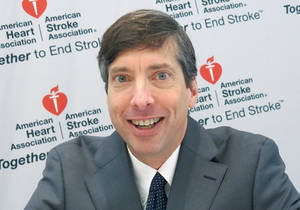
|
| Dr. Steven Greenberg |
Another message is that you can always get better. You’re never done.
This will be an ongoing effort. I don’t think you’ll see any single breakthrough but hope you’ll see small improvements and small improvements, but ones that really impact people’s lives.
Dr. Steven Greenberg, professor of neurology at Harvard Medical School in Boston, was chairman of the International Stroke Conference Program Committee. He was not involved in creating or studying Target: Stroke and reported no relevant disclosures.
This is enormously exciting. It shows that all these efforts to improve treatment time, the door-to-needle time, have a payoff. The patients did better. It shows that these interventions matter.
What strikes me is that there’s no single magic intervention. There’s no high technology or amazing breakthroughs. It’s just by making every step in the process a little bit better.

|
| Dr. Steven Greenberg |
Another message is that you can always get better. You’re never done.
This will be an ongoing effort. I don’t think you’ll see any single breakthrough but hope you’ll see small improvements and small improvements, but ones that really impact people’s lives.
Dr. Steven Greenberg, professor of neurology at Harvard Medical School in Boston, was chairman of the International Stroke Conference Program Committee. He was not involved in creating or studying Target: Stroke and reported no relevant disclosures.
This is enormously exciting. It shows that all these efforts to improve treatment time, the door-to-needle time, have a payoff. The patients did better. It shows that these interventions matter.
What strikes me is that there’s no single magic intervention. There’s no high technology or amazing breakthroughs. It’s just by making every step in the process a little bit better.

|
| Dr. Steven Greenberg |
Another message is that you can always get better. You’re never done.
This will be an ongoing effort. I don’t think you’ll see any single breakthrough but hope you’ll see small improvements and small improvements, but ones that really impact people’s lives.
Dr. Steven Greenberg, professor of neurology at Harvard Medical School in Boston, was chairman of the International Stroke Conference Program Committee. He was not involved in creating or studying Target: Stroke and reported no relevant disclosures.
SAN DIEGO – The percentage of patients arriving at hospitals with ischemic stroke who were treated with tissue plasminogen activator within the recommended 60 minutes increased from 30% to 53% on average at 1,030 hospitals engaged in the Target: Stroke program in the past 4 years.
Average time from arrival to treatment showed a significant decrease of 15 minutes, from 74 to 59 minutes. Clinical outcomes confirmed Target: Stroke’s motto that "time lost is brain lost," showing significant improvements in rates of death, symptomatic intracerebral hemorrhage, and the likelihood of being discharged home, Dr. Gregg C. Fonarow and his associates reported at the International Stroke Conference.
The study analyzed data on 71,169 patients seen for ischemic stroke at U.S. hospitals that implemented the Target: Stroke program, comparing practices and outcomes before the program launched (2003-2009) with data from after program implementation (2010-2013) and adjusting the results for patient and hospital characteristics.
Average in-hospital mortality decreased from 10% in 27,319 patients seen before Target: Stroke to 8% in the 43,850 seen after the start of the program. The proportion of patients discharged home increased from 38% to 43%, rates of symptomatic intracranial hemorrhage decreased from 6% to 5%, and complications from tissue plasminogen activator (TPA) treatment decreased from 7% to 6%, said Dr. Fonarow, chair of cardiovascular medicine and science at the University of California, Los Angeles.
After adjusting for the effects of multiple other factors, the risk of dying in the hospital decreased 11%, the risk of symptomatic intracerebral hemorrhage or TPA complications each decreased 17%, and the odds of being discharged to home increased 14%, all highly statistically significant and clinically significant outcomes, he said.
These gains were seen in secondary analyses in all subgroups, including men and women, patients older or younger than the median age of 72 years, patients with lesser or greater stroke severity, and patients of different races and ethnicities, he said at the meeting, which was sponsored by the American Heart Association (AHA).
Target: Stroke is a nationwide quality-improvement initiative launched by the AHA and the American Stroke Association (ASA) in 2010 that identified 10 evidence-based strategies that are associated with timely stroke reperfusion and are feasible for hospitals to implement rapidly and cost effectively, Dr. Fonarow said.
The project also supplied clinical decision support tools, performance feedback, and other tools to help hospitals reduce door-to-needle times to less than an hour for most ischemic stroke patients. He and his colleagues described the design and rationale of the initiative in an earlier article (Stroke 2011;42:2983-9).
Only 16% of U.S. hospitals had door-to-needle times of 60 minutes or less in 2009, right before Target: Stroke launched. By 2013, that proportion "increased markedly" to 47% of participating hospitals meeting this benchmark, he said. In 4 years, the project achieved its goal of having at least half of ischemic stroke patients get TPA within an hour of arrival, which would have taken 15 or more years if rates of progress before Target: Stroke had persisted.
The AHA/ASA set a new target for phase II of Target: Stroke, which was launched at the meeting: Reducing door-to-needle times to less than an hour for at least 75% of ischemic stroke patients at participating hospitals.
The current study controlled for the effects of age, sex, race, history of atrial fibrillation, prosthetic heart valve, previous stroke or transient ischemic attack, coronary heart disease or prior MI, carotid stenosis, peripheral vascular disease, hypertension, dyslipidemia, current smoking, stroke severity, arrival time and mode, onset-to-arrival time, hospital size, region, annual volume of TPA, annual stroke discharge, and whether the facility was a teaching hospital or a certified stroke center.
Dr. Fonarow said that it was not feasible to include a true control group of hospitals that did not join the program because the lack of participation in nationwide quality improvement programs makes it difficult to gather data from those facilities.
He and his associates previously reported that, before Target: Stroke, most U.S. stroke patients were not receiving TPA within an hour of arrival at a hospital (Circulation 2011;123:750-8).
Dr. Fonarow and one of his associates in the study are employees of the University of California, which holds a patent on retriever devices for treating acute stroke. Five of his coauthors reported financial associations with multiple companies, some of which make treatments and devices for stroke.
On Twitter @sherryboschert
SAN DIEGO – The percentage of patients arriving at hospitals with ischemic stroke who were treated with tissue plasminogen activator within the recommended 60 minutes increased from 30% to 53% on average at 1,030 hospitals engaged in the Target: Stroke program in the past 4 years.
Average time from arrival to treatment showed a significant decrease of 15 minutes, from 74 to 59 minutes. Clinical outcomes confirmed Target: Stroke’s motto that "time lost is brain lost," showing significant improvements in rates of death, symptomatic intracerebral hemorrhage, and the likelihood of being discharged home, Dr. Gregg C. Fonarow and his associates reported at the International Stroke Conference.
The study analyzed data on 71,169 patients seen for ischemic stroke at U.S. hospitals that implemented the Target: Stroke program, comparing practices and outcomes before the program launched (2003-2009) with data from after program implementation (2010-2013) and adjusting the results for patient and hospital characteristics.
Average in-hospital mortality decreased from 10% in 27,319 patients seen before Target: Stroke to 8% in the 43,850 seen after the start of the program. The proportion of patients discharged home increased from 38% to 43%, rates of symptomatic intracranial hemorrhage decreased from 6% to 5%, and complications from tissue plasminogen activator (TPA) treatment decreased from 7% to 6%, said Dr. Fonarow, chair of cardiovascular medicine and science at the University of California, Los Angeles.
After adjusting for the effects of multiple other factors, the risk of dying in the hospital decreased 11%, the risk of symptomatic intracerebral hemorrhage or TPA complications each decreased 17%, and the odds of being discharged to home increased 14%, all highly statistically significant and clinically significant outcomes, he said.
These gains were seen in secondary analyses in all subgroups, including men and women, patients older or younger than the median age of 72 years, patients with lesser or greater stroke severity, and patients of different races and ethnicities, he said at the meeting, which was sponsored by the American Heart Association (AHA).
Target: Stroke is a nationwide quality-improvement initiative launched by the AHA and the American Stroke Association (ASA) in 2010 that identified 10 evidence-based strategies that are associated with timely stroke reperfusion and are feasible for hospitals to implement rapidly and cost effectively, Dr. Fonarow said.
The project also supplied clinical decision support tools, performance feedback, and other tools to help hospitals reduce door-to-needle times to less than an hour for most ischemic stroke patients. He and his colleagues described the design and rationale of the initiative in an earlier article (Stroke 2011;42:2983-9).
Only 16% of U.S. hospitals had door-to-needle times of 60 minutes or less in 2009, right before Target: Stroke launched. By 2013, that proportion "increased markedly" to 47% of participating hospitals meeting this benchmark, he said. In 4 years, the project achieved its goal of having at least half of ischemic stroke patients get TPA within an hour of arrival, which would have taken 15 or more years if rates of progress before Target: Stroke had persisted.
The AHA/ASA set a new target for phase II of Target: Stroke, which was launched at the meeting: Reducing door-to-needle times to less than an hour for at least 75% of ischemic stroke patients at participating hospitals.
The current study controlled for the effects of age, sex, race, history of atrial fibrillation, prosthetic heart valve, previous stroke or transient ischemic attack, coronary heart disease or prior MI, carotid stenosis, peripheral vascular disease, hypertension, dyslipidemia, current smoking, stroke severity, arrival time and mode, onset-to-arrival time, hospital size, region, annual volume of TPA, annual stroke discharge, and whether the facility was a teaching hospital or a certified stroke center.
Dr. Fonarow said that it was not feasible to include a true control group of hospitals that did not join the program because the lack of participation in nationwide quality improvement programs makes it difficult to gather data from those facilities.
He and his associates previously reported that, before Target: Stroke, most U.S. stroke patients were not receiving TPA within an hour of arrival at a hospital (Circulation 2011;123:750-8).
Dr. Fonarow and one of his associates in the study are employees of the University of California, which holds a patent on retriever devices for treating acute stroke. Five of his coauthors reported financial associations with multiple companies, some of which make treatments and devices for stroke.
On Twitter @sherryboschert
AT THE INTERNATIONAL STROKE CONFERENCE
Major finding: The percentage of patients with ischemic stroke who got TPA within 1 hour of hospital arrival increased from 30% before Target: Stroke to 53% after implementation.
Data source: An analysis of data on 71,169 stroke patients at 1,030 U.S. hospitals.
Disclosures: Dr. Fonarow and one of his associates in the study are employees of the University of California, which holds a patent on retriever devices for treating acute stroke. Five of his coauthors reported financial associations with multiple companies, some of which make treatments and devices for stroke.
